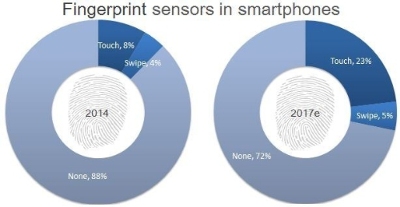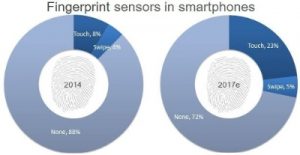Fingerprint Sensor Market in Smart Mobile Devices — Global Trends
SANTA CLARA, Calif., Component revenues expected to grow from $3 million in 2012 to $3 billion in 2019.
2014 was a watershed year for fingerprint sensors in smartphones. Apple’s iPhone 6 coupled the company’s new mobile payment service with a touch-type fingerprint sensor creating a wow effect among consumers. The use of biometrics for the authorization of financial transactions has a futuristic appeal and an allure of improved security and convenience.
Realizing they had to match Apple’s sudden mobile payment lead, Apple’s competitors have reacted quickly. Samsung, for example, recently unveiled its own payment service coupled with a touch fingerprint sensor for authentication. It was an expected move, and the company’s use of a magnetic-stripe compatible technology could give Samsung the volume lead. Now other smart device vendors are expected to introduce a similar set of features in their next iteration of flagship phones.
With more than 10 billion smartphones and tablets expected to be shipped during the coming five years, related component volumes are expected to soar. Market research firm Research Capsule, expects fingerprint sensors will be joining the cast of now ubiquitous smartphone sensors though market penetration will vary by device price tiers.
Critical mass
In its new report entitled “Fingerprint Sensors in Smart Mobile Devices,” Research Capsule examines current and planned usage of fingerprint sensors in smartphones and tablets and forecasts implementations to 2019. The report coverage includes the market breakdown by touch and swipe sensors, and sales volumes and revenues by region: North America, Western Europe, Eastern Europe, Asia Pacific, Middle East & Africa, and Latin America.
The global market for fingerprint sensors in mobile devices is expected to become a multi-billion dollar market by 2019. While North America has been the key driver of fingerprint sensor adoption during the early years, adoption in the APAC region is expected to take the lead in 2015. Globally, the inclusion of fingerprint sensors in smartphones is reaching a critical mass driving it to become a mainstream smartphone feature in many markets. ReCap forecasts that 50% of smartphones sold by 2019 will have a fingerprint sensor.
The key initial driver
Research Capsule believes that mobile payment will continue to be the primary driver for fingerprint sensors with the number of use cases expanding during the coming years. The volumes will be significant and though there are currently only a limited number of component vendors supplying the sensors, the flurry of activity is attracting both startups and established telecomm players to cater to this hot market.
Qualcomm’s recent introduction of its Snapdragon Sense ID ultrasonic-based fingerprint sensor could be a substantial disruptor to current component suppliers. The company’s wide industry footprint and relationship with most major smartphone vendors could propel it to a leadership position just as the market is reaching mainstream. Qualcomm’s entry into the fingerprint market was expected after it acquired Ultra-Scan several years back, but the demonstrations recently given at Mobile World Congress were impressive and shipments could happen sooner than expected.


